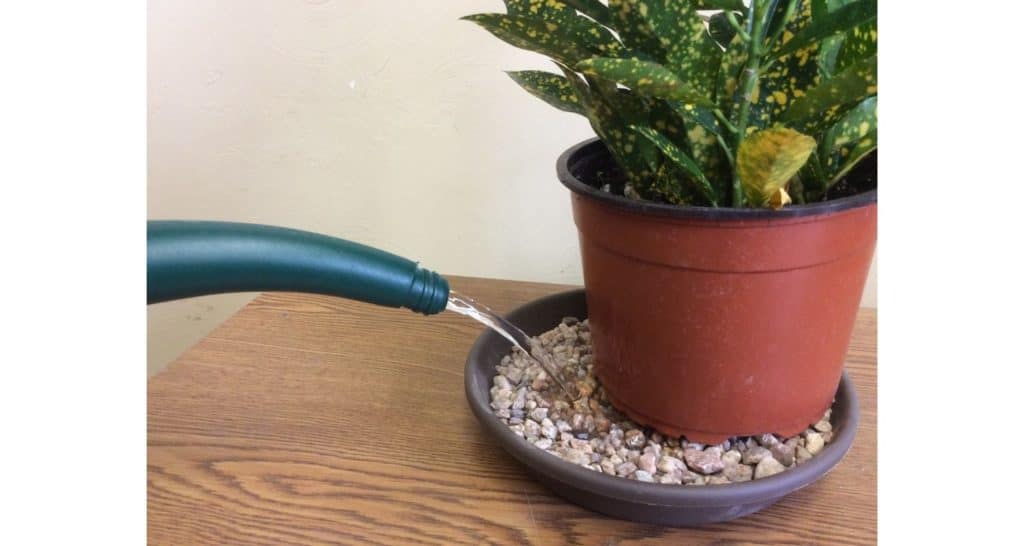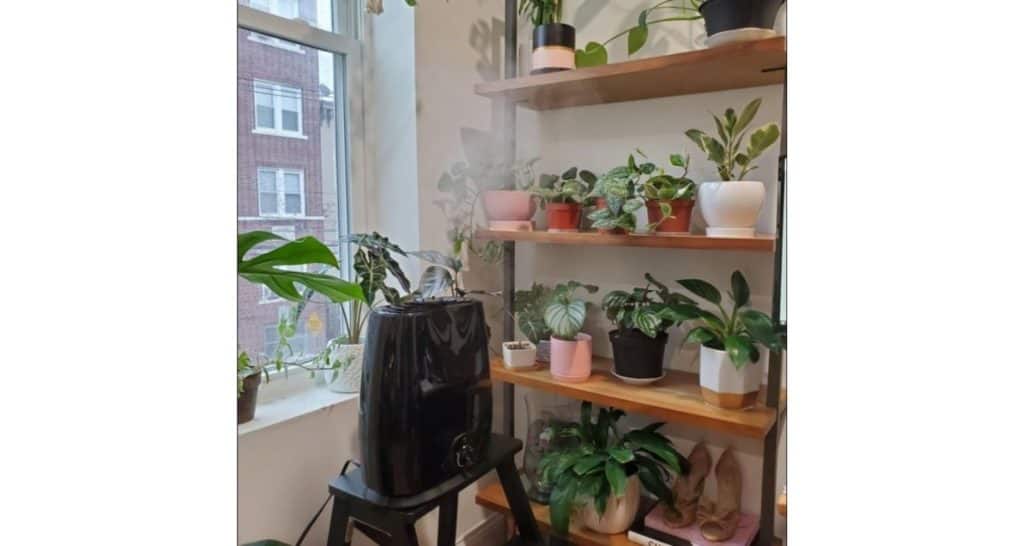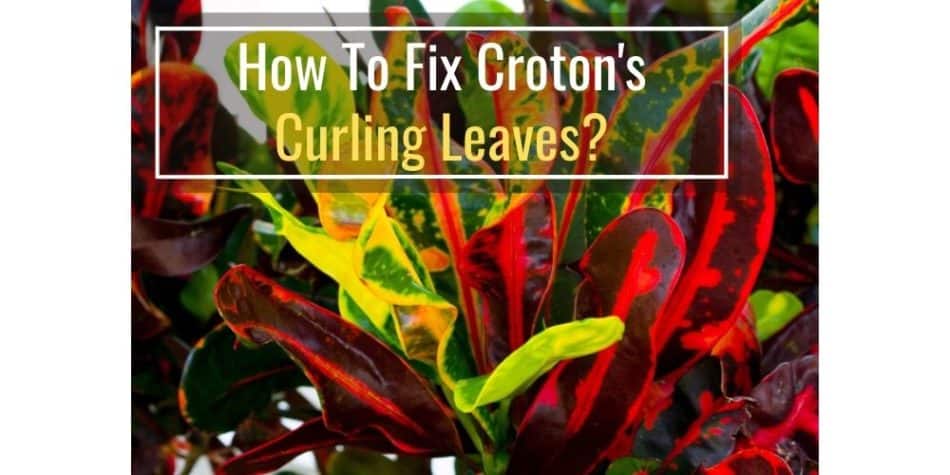The Croton – or the Codiaeum variegatum – is a popular houseplant, native to Pacific regions such as Asia and Australia. As it originates from a tropic, humid environment, the Croton can prove particularly difficult to care for when away from its native home.
If you find yourself with a brown, dried up Croton on your hands, the first thing to do is give the stem a little rub with your nail.
See green underneath the brown? Then your Croton has a chance of making a full recovery.
Whether the leaves curl up and wilt or they drop off altogether, your Croton will make you well aware when you have a problem. All you have to do is narrow down what that problem might be.
Croton’s with curling leaves are signaling there is an issue from one of the following reasons:
- Over or Underwatering
- Humidity and Temperature
- Stress
- Light
- Pests
Now, let’s take a look at each one of these issues in more detail so we can get your Croton back to the thriving, ornamental beauty it should be.
Overwatering and Underwatering Crotons
The difficult part with Crotons is that both over watering and under watering can cause leaves to drop.
Pay attention to the croton’s leaves to determine if the plant is suffering from over watering or under watering:
- If the croton’s leaves at the bottom of the plant are beginning to dry up and drop off or the tips are turning brown then you are likely under-watering.
- If the croton’s leaves are wilting or curling on the entire plant then you are likely over-watering.
Curling or wilting leaves is an early sign of stress in the croton so there is still time to fix the issue.
Here are some tips on how to prevent curling leaves on Crotons.
Tips To Prevent Curling Leaves On Crotons
Crotons should be planted in pots that contain drainage holes on the bottom. Make sure to use potting soil that drains wells but also retains moisture.
High quality indoor potting soil will help retain just the right amount of water and prevent the Croton’s roots from rotting.
Another good tip when growing a Croton is to have the plant’s pot sit on top of a pebble tray.
Pebble trays will catch the excess runoff water from the plant and also increase the humidity in the air as the water evaporates. So pebble trays are an incredibly effective tool to resolve curling leaves on tropical plants.
How To Create DIY Humidifier: Pebble Tray
In order to make a pebble tray:
- Select a shallow tray that is larger than the base of the plant’s pot
- Fill the tray with a single layer of pebbles
- Add water so it rises to about halfway up the rocks

That’s it! You have now created a simple but effective pebble tray for increasing the humidity in the air.
When To Water Croton Houseplants
The watering routine for the Croton varies between seasons.
From October until February, new growth in the plant is suspended meaning it needs less light and less water. In the fall/winter months wait until the top two inches of the soil are dry before watering with room temperature water.
During the growing season – spring and summer – you will need to water more frequently. In the spring/summer months wait until about an inch of the soil is dry before watering with room temperature water.
Make sure to water the croton plant until water begins running out of the drainage hole into the pebble tray or water catcher.
Crotons Prefer High Humidity
Crotons naturally grow in tropical regions which is why they thrive on warmth and humidity. While it can be challenging to provide a high humidity environment inside of a modern home – it is still possible.
Here are three great options for providing a higher humidity environment for a croton houseplant.
Placing Croton In High Humidity Rooms
The first option is to put your Croton in a brightly-lit bathroom or indoor pool area. Both of these rooms or areas are high in humidity which is exactly what Crotons prefer.
If your bathroom does not have natural light then you can either use indoor grow lights or follow one of the other options below.
Creating Humidity For Croton
As explained above, using a pebble-tray can provide humidity while also helping to protect the Croton from overwatering.
Pebble trays are a low cost way to provide humidity to tropical plants.
Alternatively, you can place a humidifier in the room with all of your tropical plants. A humidifier will allow you to adjust the settings to provide the right amount of humidity year round.

I use this humidifier in my room and it lasts for about 2 days before needing to be refilled. I highly recommend it for a low maintenance way of keeping the room humid.
Misting Croton Plants
The third option for providing more humidity to croton plants is to periodically mist them.
The Croton plant can be misted with room temperature water every day in the spring/summer months to provide moisture, and every 1-2 days in the fall/winter months.
The ideal humidity range for the Croton is anywhere between 40 and 80 percent. Ideally Croton’s prefer the humidity to be around 70 percent.
You can use a tool called a hygrometer in order to measure the humidity around the plant
You can buy a tool called a hygrometer, which can help you keep track of your humidity levels.
Ideal Temperature For Crotons
Crotons thrive in a warm environment that is away from any sort of draft.
You will want to place your Croton plant well away from fans, heating vents, radiators, and any window or door that may be frequently opening and closing.
The Croton will be happiest in temperatures above 60 degrees. So Crotons can be moved outside in the spring as long as the outdoor temperature is well above 60 degrees.
Keep in mind that soil temperature can be much colder than the air temp.
Preventing Croton Stress
Speaking of moving a Croton…try not to.
Crotons hate change. Any change in location (including bringing them home from the shop) will likely result in them having a plant panic-attack and dropping their leaves.
Similar to Fittonias (Nerve Plants), Crotons are dramatic plants and prominently display signs of stress.
Crotons will recover from stress although it will take a few months. New green leaves will take about 3-4 weeks to appear, so don’t give up!
Ideal Light For Crotons
Known best for their vibrant coloured leaves, Crotons can be found in shades of green, yellow, red, pink and even purple. Some Croton varieties boast stylish spots and others distinctive patterned veins.
No matter which type you choose, your Croton can offer a bright splash of color in your home.
Croton’s colors come from light – which means the leaves need a lot of it.
A Croton does best when it receives at least six to eight hours of indirect sunlight. If the leaves are starting to fade then chances are your plant needs more light. Place the croton in a spot that gets plenty of bright, indirect sunlight.
Common Pests On Crotons
Most Croton pests can be discouraged by regular watering and misting, but if your plant is suffering from an infestation then there are steps that can be taken.
Spider Mites On Croton Leaves
One of the pests who will want to prey on your Croton is the dreaded spider-mite.
Spider-mites will appear as small red or white dots, mainly located on the underside of the leaf. You may also see small webs present.
The best way to get rid of spider-mites is to thoroughly wash all of the leaves. Allow the croton plant to dry before wiping the leaves with warm soapy water. Repeat this treatment until the spider-mites are gone.
Read this guide on how to make a plant safe soapy spray since many soaps are actually detergents which can damage your plant’s leaves.
Other Common Pests On Crotons
Other common pests include mealybugs, plant scale, and thrips.
Thrips cause the leaves to develop silvery or brownish steaks on them. Cut infected leaves off and discard them before treating the rest of the plant.
To get rid of mealybugs and scales, simply brush them off using a cotton-swab dipped in alcohol or the light stroke of a toothbrush. Wipe the leaves thoroughly with alcohol or warm soapy water.
Personally I recommend using a home-made insecticide spray by mixing castile soap and water and spraying it directly on the plant.
Final Thoughts
The Croton plant is a vibrant addition to any home. With some proper care, a Croton will continue to provide vibrant colors for years to come.
Pay attention to your plant, and it will let you know when something is wrong. Most issues can be resolved when caught early so paying attention to the plant is the most importnat step.
One other thing to note is that all parts of the Croton are poisonous. When pruning a Croton, be sure to use gloves to avoid the milky, toxic sap, and keep your Croton away from small children or animals who may be inclined to give it more than just a passing glance.
Best of luck plant-parents!

